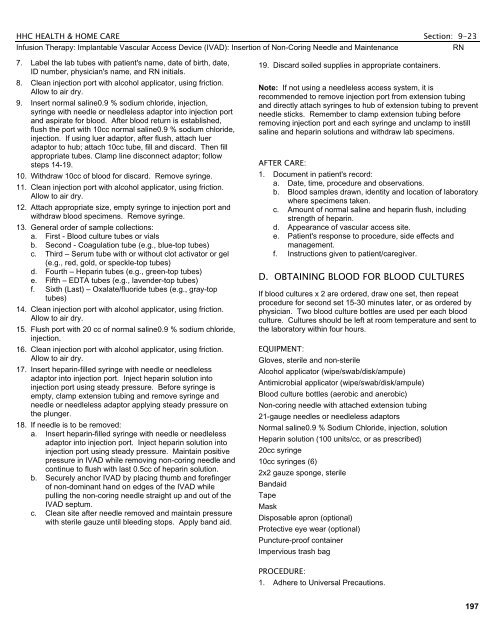HHC Health & Home Care Clinical Policy And
HHC Health & Home Care Clinical Policy And
HHC Health & Home Care Clinical Policy And
Create successful ePaper yourself
Turn your PDF publications into a flip-book with our unique Google optimized e-Paper software.
<strong>HHC</strong> HEALTH & HOME CARE Section: 9-23<br />
Infusion Therapy: Implantable Vascular Access Device (IVAD): Insertion of Non-Coring Needle and Maintenance RN<br />
7. Label the lab tubes with patient's name, date of birth, date,<br />
ID number, physician's name, and RN initials.<br />
8. Clean injection port with alcohol applicator, using friction.<br />
Allow to air dry.<br />
9. Insert normal saline0.9 % sodium chloride, injection,<br />
syringe with needle or needleless adaptor into injection port<br />
and aspirate for blood. After blood return is established,<br />
flush the port with 10cc normal saline0.9 % sodium chloride,<br />
injection. If using luer adaptor, after flush, attach luer<br />
adaptor to hub; attach 10cc tube, fill and discard. Then fill<br />
appropriate tubes. Clamp line disconnect adaptor; follow<br />
steps 14-19.<br />
10. Withdraw 10cc of blood for discard. Remove syringe.<br />
11. Clean injection port with alcohol applicator, using friction.<br />
Allow to air dry.<br />
12. Attach appropriate size, empty syringe to injection port and<br />
withdraw blood specimens. Remove syringe.<br />
13. General order of sample collections:<br />
a. First - Blood culture tubes or vials<br />
b. Second - Coagulation tube (e.g., blue-top tubes)<br />
c. Third – Serum tube with or without clot activator or gel<br />
(e.g., red, gold, or speckle-top tubes)<br />
d. Fourth – Heparin tubes (e.g., green-top tubes)<br />
e. Fifth – EDTA tubes (e.g., lavender-top tubes)<br />
f. Sixth (Last) – Oxalate/fluoride tubes (e.g., gray-top<br />
tubes)<br />
14. Clean injection port with alcohol applicator, using friction.<br />
Allow to air dry.<br />
15. Flush port with 20 cc of normal saline0.9 % sodium chloride,<br />
injection.<br />
16. Clean injection port with alcohol applicator, using friction.<br />
Allow to air dry.<br />
17. Insert heparin-filled syringe with needle or needleless<br />
adaptor into injection port. Inject heparin solution into<br />
injection port using steady pressure. Before syringe is<br />
empty, clamp extension tubing and remove syringe and<br />
needle or needleless adaptor applying steady pressure on<br />
the plunger.<br />
18. If needle is to be removed:<br />
a. Insert heparin-filled syringe with needle or needleless<br />
adaptor into injection port. Inject heparin solution into<br />
injection port using steady pressure. Maintain positive<br />
pressure in IVAD while removing non-coring needle and<br />
continue to flush with last 0.5cc of heparin solution.<br />
b. Securely anchor IVAD by placing thumb and forefinger<br />
of non-dominant hand on edges of the IVAD while<br />
pulling the non-coring needle straight up and out of the<br />
IVAD septum.<br />
c. Clean site after needle removed and maintain pressure<br />
with sterile gauze until bleeding stops. Apply band aid.<br />
19. Discard soiled supplies in appropriate containers.<br />
Note: If not using a needleless access system, it is<br />
recommended to remove injection port from extension tubing<br />
and directly attach syringes to hub of extension tubing to prevent<br />
needle sticks. Remember to clamp extension tubing before<br />
removing injection port and each syringe and unclamp to instill<br />
saline and heparin solutions and withdraw lab specimens.<br />
AFTER CARE:<br />
1. Document in patient's record:<br />
a. Date, time, procedure and observations.<br />
b. Blood samples drawn, identity and location of laboratory<br />
where specimens taken.<br />
c. Amount of normal saline and heparin flush, including<br />
strength of heparin.<br />
d. Appearance of vascular access site.<br />
e. Patient's response to procedure, side effects and<br />
management.<br />
f. Instructions given to patient/caregiver.<br />
D. OBTAINING BLOOD FOR BLOOD CULTURES<br />
If blood cultures x 2 are ordered, draw one set, then repeat<br />
procedure for second set 15-30 minutes later, or as ordered by<br />
physician. Two blood culture bottles are used per each blood<br />
culture. Cultures should be left at room temperature and sent to<br />
the laboratory within four hours.<br />
EQUIPMENT:<br />
Gloves, sterile and non-sterile<br />
Alcohol applicator (wipe/swab/disk/ampule)<br />
Antimicrobial applicator (wipe/swab/disk/ampule)<br />
Blood culture bottles (aerobic and anerobic)<br />
Non-coring needle with attached extension tubing<br />
21-gauge needles or needleless adaptors<br />
Normal saline0.9 % Sodium Chloride, injection, solution<br />
Heparin solution (100 units/cc, or as prescribed)<br />
20cc syringe<br />
10cc syringes (6)<br />
2x2 gauze sponge, sterile<br />
Bandaid<br />
Tape<br />
Mask<br />
Disposable apron (optional)<br />
Protective eye wear (optional)<br />
Puncture-proof container<br />
Impervious trash bag<br />
PROCEDURE:<br />
1. Adhere to Universal Precautions.<br />
197







